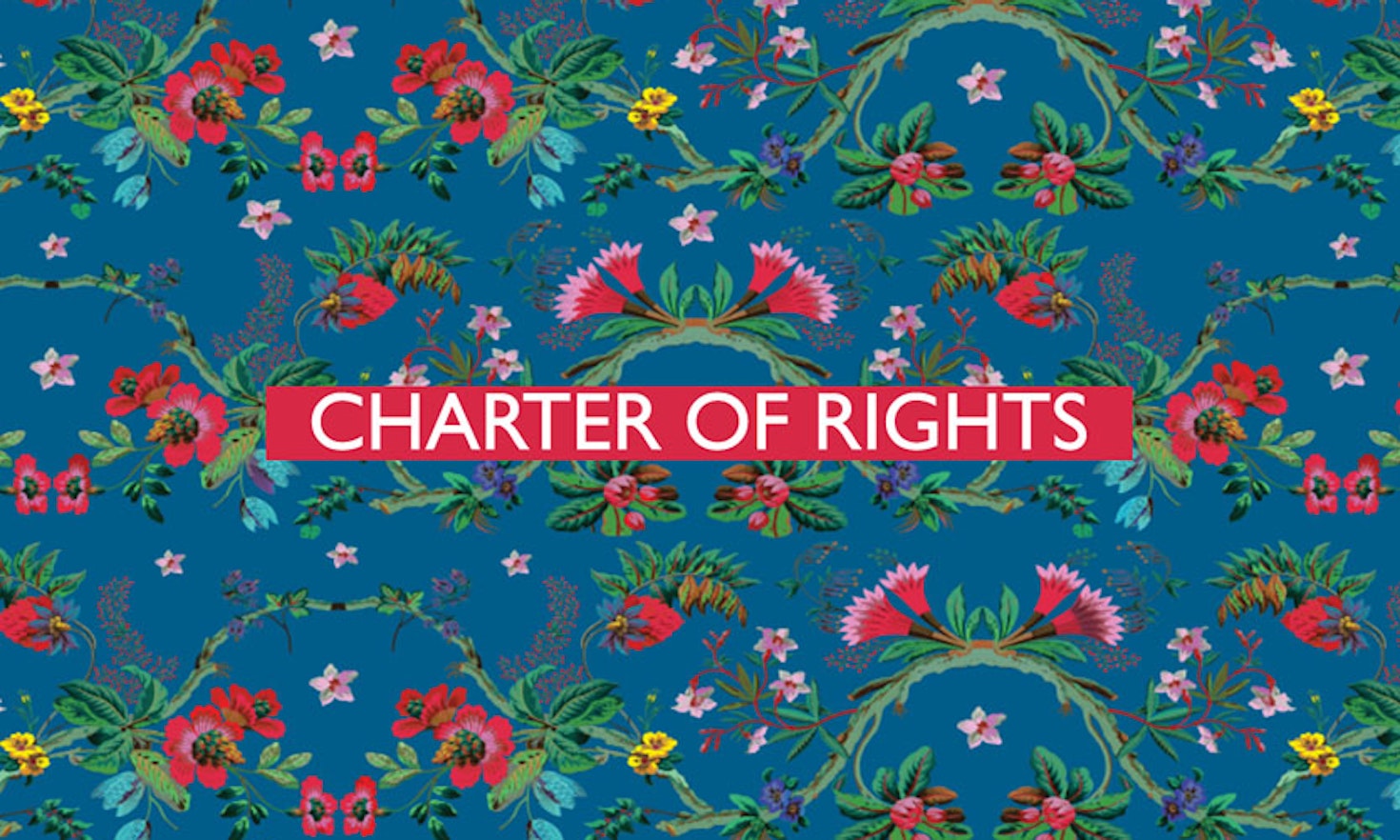The Charter of Fundamental Rights: ‘All EU-r rights’ in 54 provisions

We tend to think that in America everything is newer than in Europe. This year the US bill of rights turned 230 years old. In contrast, the EU Charter of fundamental rights only entered into force on 1 December 2009, exactly 10 years ago.
Surveys have shown that Americans are more likely to name two members of the fictional Simpsons family than provide the content of two of their bill’s rights. But don’t smile yet. Europeans might be in worse shape. A recent EU survey confirms that well over half of European population have no clue what the Charter is.
With this in mind, the EU ministers came together to emphasise the need “to foster the citizens’ ownership of the Charter”.[1] But is it worthwhile to learn more about this document? What is this “Charter of Fundamental Rights”?
”The Charter of…”
The Cambridge dictionary defines a “Charter” as a formal statement of the rights of a country’s people or of an organisation. So far, so good. A “Charter” is not, however, a typical form in which EU law can be enacted. In fact the Charter is a hybrid creature. It is not an integral part of the EU treaties, but it has “the same legal value” as these treaties.[2] In this sense the Charter is ‘non-treaty treaty law’.
This hybrid character does not have practical implications. Unless people would like to have the Charter’s content changed, as a recent project by two artists from Germany might suggest: they invited citizens to discuss whether the Charter’s text needs an update. How such a change can take place, legally speaking, is unclear.[3] Placing the Charter outside of the EU treaties was not beneficial either to the intention of the Charter, namely to make the “overriding importance and relevance” of EU fundamental rights “more visible to the Union’s citizens”.[4]
However, the name “Charter” clearly conveys one message: the document is about a full-fledged list of rights.
“…Fundamental…”
Secondly, the Charter’s name is clear about the fundamental nature of the document. Given that the Charter has the same legal value as the treaties, all EU legislation has to be in conformity with it, or risk being declared null and void by the EU Court of Justice in Luxembourg.[5] As a piece of EU law, the Charter is supreme over national law as well. Some of the Charter’s provisions are even binding for private parties, for instance, when concluding a contract.[6]
That the Charter uses the term fundamental rather than human rights signals that this is about the EU’s internal dimension and not about situations inside third countries or international law where the EU still prefers the term “human rights”. The term establishes a parallel to the Member States constitutional systems that often use the term fundamental in relation to rights. In fact, the Chairperson of the European Convention drafting the Charter – Roman Herzog, a former president of Germany – said in his opening speech: “it is time to give a clear signal to the outside world that the European Union must not be any less bounden to its citizens than are the Member States under their own constitutional laws.”[7]
Back then, some criticised the EU for mimicking the Member States.[8] But let’s be clear: this fundamental document was not crafted by anonymous bureaucrats. Quite the contrary. Forty-six of the 62 members of the European Convention drafting the Charter were Parliamentarians. Representatives from all EU Member State governments co-drafted and agreed upon the Charter’s text. Civil society was invited to submit proposals.[9] In short: the genesis of the Charter was an open and participatory process, which further adds legitimacy to this document of constitutional relevance.
“…Rights”
The over 50 articles of the Charter represent a codification of the current international human rights law obligations. To this consensus, the Charter adds three additional elements.
- Firstly, the Charter is visibly an EU Document as it addresses the specificities of the EU. EU specific rights such as the freedom of movement[10] find their place in the Charter, just as rights guaranteeing political participation at EU level[11] or the efficient interaction with the EU administration[12].
- Secondly, the Charter is pronouncedly modern‚ as it phrases rights in a language that describes their current meaning. For instance, the Charter explicitly opens the right to marry to unions between same sex couples. And the Charter‘s modernity does not stop here. It vests entitlements in a human rights language that so far would not have been classified as such. The right to consumer protection[13] and the right to conduct a business[14] are examples in this regard.
- Thirdly, and maybe most remarkably, the Charter is a major exception compared to other international human rights law in that it combines in one single, legally binding document both civil-political (e.g., the right to freedom and security) and socio-economic rights (e.g., the right to health or to social protection) – just like the 1948 Universal Declaration of Human Rights.
This major breakthrough did not come for free. To accommodate the resistance of a certain (currently brexiting) Member State, it was necessary to add a provision[15] specifying that the Charter contains next to (strong) rights which can be invoked before courts also other, legally speaking weaker provisions, namely (mere) “principles” which cannot be directly invoked before courts. This episode in the drafting of the Charter should not, however, lead to the conclusion that none of the socio-economic provisions in the Charter were ’proper‘ rights.[16]
So what?
The 3,860 words of the Charter of Fundamental Rights are drafted in an accessible language. The majority of the Charter provisions consist of one single sentence. But already the distinction between rights and principles shows that the Charter is ’easy to read but difficult to understand‘. What adds even more complexity: Unlike the Council of Europe‘s European Convention on Human Rights (ECHR), the Charter is not always binding on the States. Legally speaking, the Charter only applies when a State acts within the scope of EU law. This means: Besides the Charter, a second EU legal act is required that would be applicable in a specific situation. This creates a considerable potential for frustration.[17] Every year, the European Commission has to send many hundreds of disappointing letters to citizens who thought the Charter could provide help, only to learn that their case fell outside the (in)famous ’scope of EU law’. So, is the Charter an ‘Illusionary giant’ that looks great from far away but shrinks once one takes a closer look?
Such a view would ignore what this still quite new instrument already achieved! The Charter has sparked a new fundamental rights culture in EU institutions. It has turned from a legal ornament into a legal order. At a national level as well, the courts have shown that the Charter can have a considerable impact. Moreover, the Charter is a concrete expression of the values shared by the EU and the 28 Member States. For this reason alone, it is worthwhile to study the Charter. A Simpson series about the Charter might be an option to render the Charter better known. Or, alternatively a blog series dedicated to the Charter. Well, here you are: ‘All EU-r rights‘, stay tuned!
 |
Gabriel N. Toggenburg is an Honorary Professor for European Union and Human Rights Law at the University of Graz, Austria. He worked as a Senior Researcher for Eurac Research in Bolzano/Bozen (Italy) from 1998 to 2008. Since 2009, he has been working for the European Union. All views expressed are his own and cannot be attributed to his current or former employers. His blog series “All EU-r rights” published on EUreka! aims at making the EU Charter of Fundamental Rights better known. He is grateful for the honour to have every blog entry introduced by a piece of art by Miloladesign. An annotated list of all Charter rights is available here. |
[1] Council of the EU, Conclusion on the Charter of fundamental rights after ten years: state of play and future work.
[2] Art. 6(1) of the Treaty on the European Union (TEU).
[3] Art. 48 TEU only defines how “the treaties” can be amended.
[4] European Council decision on the drawing up of a Charter, see Annex IV of the European Council conclusions of Cologne, June 1999.
[5] As happened for example to the Data Retention Directive, see CJEU, Judgment in Joined Cases C-293/12 and C-594/12, 8 April 2014.
[6] So far the CJEU has accepted direct horizontal effect for the following provisions: Art. 21, Art. 47, Art. 31(2).
[7] Speech given at the first meeting of the Convention on 17.12.1999.
[8] Almost all EU Member States have fundamental rights catalogue in written constitutional law. There are three different ways in that regard: the vast majority of States have a catalogue of rights that is an integral part of their text of the constitution. In close to half of the Member States, this is in part 2 of the respective constitution – unsurprisingly, the draft “treaty for establishing a constitution for Europe” (which failed in 2005 in referenda in France and the Netherlands) took exactly that approach: the Charter was meant to become part II of that treaty. A second group of States – Austria (Basic State Law), France (Declaration of Human rights), Czech Republic (Charter of Fundamental Rights) – place the rights in a document outside the text of the constitution (the current EU model). And finally there are states like Denmark or Sweden where fundamental rights are not concentrated in a catalogue but spread out over the constitutional system.
[16] At maximum one could go as far as to argue for a rebuttable presumption that Charter provisions under title IV (solidarity) are principles rather than rights – an avenue chosen by the General Advocate Opinion of 18.07.2013, Case 176/12, Para 55.
[17] The European Union Agency for Fundamental Rights (FRA) has developed an interactive tool that aims to avoid such frustration by pointing citizens to the right addressee. FRA also produced a 5 minutes video presenting the Charter: “apply the Charter, deliver our rights!”
Citation
This content is licensed under a Creative Commons Attribution 4.0 International license except for third-party materials or where otherwise noted.
![[DE] Schwächt Covid-19 Italiens Regionen? Die Frage ist, ob die krisenbedingte Zentralisierung sich verfestigt.](https://webassets.eurac.edu/31538/1599754597-erik-mclean-qvgdn0yeba-unsplashresized.jpg?w=425&h=288&fit=crop&crop=focalpoint&fp-x=0.5&fp-y=0.5&auto=[format,compress]&cs=origin&dpr=1)
[DE] Schwächt Covid-19 Italiens Regionen? Die Frage ist, ob die krisenbedingte Zentralisierung sich verfestigt.
 Karl Peter Kössler
Karl Peter Kössler
Looking for European Solidarity in Times of Crisis
 Birgit Sandu Gociu
Birgit Sandu Gociu
The 11th of all EU-r rights: freedom of expression and how the Charter contributes
 Gabriel Toggenburg
Gabriel Toggenburg
